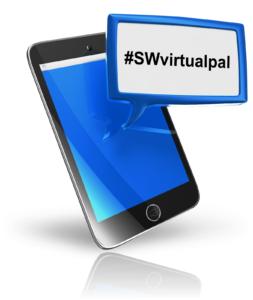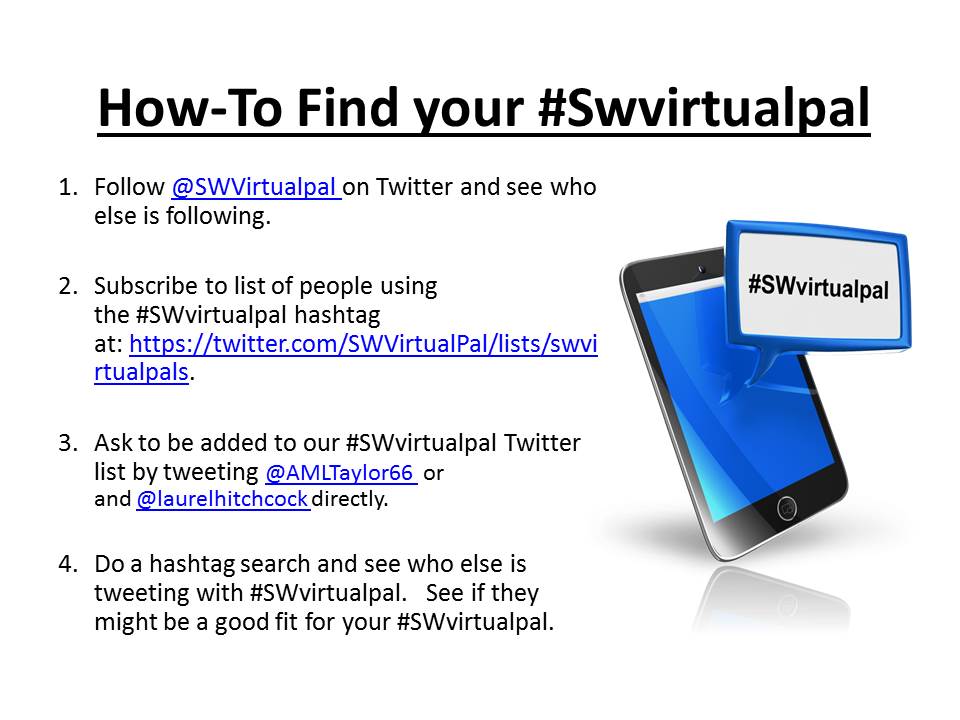The purpose of the #SWVirtualpal hashtag is to create professional connections between social work students, practitioners, and academics across the planet. It was created by Amanda Taylor from the University of Central Lancashire in the United Kingdom, and Laurel Iverson Hitchcock from the University of Alabama at Birmingham in the United States. To learn more about #SWVirtualPal, read this blog post.
Why #SWVirtualpal in Social Work Education?
 Pen Pals have been a ‘thing’ for a very long time. The earliest record of their usage, that we can find, is reported as being led by an ‘innovative Iowa teacher’ called Birdie Matthews, who at the time employed the methodology to bring the realities of WW II into the classroom (Myers-Verhage, 1995). Matthews creativity in the classroom quite possibly led to one of the most famous pen pal relationships of all time, and this was between Juanita Wagner (her student at the time) and Anne Frank. So why are we telling you all of this? Well, before the internet the likelihood of a social work academic in the US, working closely and supportively with a social work academic in the UK would have been ‘virtually’ unheard of, or indeed a fairly disparate affair, which would have been laborious to maintain. However, thankfully for us technologies have changed the way we work and the way we connect. Today’s digital and social media present all sorts of possibilities and opportunities; and being social workers with our default set on creativity, we decided quite a way back now to exploit all it is that technology affords.
Pen Pals have been a ‘thing’ for a very long time. The earliest record of their usage, that we can find, is reported as being led by an ‘innovative Iowa teacher’ called Birdie Matthews, who at the time employed the methodology to bring the realities of WW II into the classroom (Myers-Verhage, 1995). Matthews creativity in the classroom quite possibly led to one of the most famous pen pal relationships of all time, and this was between Juanita Wagner (her student at the time) and Anne Frank. So why are we telling you all of this? Well, before the internet the likelihood of a social work academic in the US, working closely and supportively with a social work academic in the UK would have been ‘virtually’ unheard of, or indeed a fairly disparate affair, which would have been laborious to maintain. However, thankfully for us technologies have changed the way we work and the way we connect. Today’s digital and social media present all sorts of possibilities and opportunities; and being social workers with our default set on creativity, we decided quite a way back now to exploit all it is that technology affords.
Our mutual interests in creative teaching methodologies and an awareness of the benefits of digitalization led to us connecting online, via twitter… neither of us can actually remember when or why but it is suffice to say our like-mindedness took control. A fairly recent Skype chat highlighted that us being together in the same space was not going to result in any other than trouble and it is in this blog that we would like to offer you all the opportunity to join us in our troublesome-ness. Why do we use the word trouble? Well we are all so busy and never have enough time to do everything we want to do … this was pretty much how the conversation went. But once we got past this the need to create and innovate overtook. We talked about connections and the benefits of being connected. We talked about geography and shared ideas and resources about ‘connectography’ (Khanna, 2016), and the way in which the world is becoming a smaller place and also a much more diverse place. We went on to think about our respective student groups and how we could facilitate their learning in terms of the wider world. This for one reason or another led us to the notion of peer support, communities of learning and the fact that exposure to knowledge did not need to be such a local affair. Within these creative moments we came up with the idea of social work pen pals. We thought about how pre-modern digitization – the pen and paper technologies – facilitated connections and how that we had at our fingertips Twitter, a device and the hashtag.
How to use #SWVirtualPal in Social Work Education?
The hashtag can be used to connect with social worker students in any location – another county or country. There are many advantages to having a #SWvirtualpal such as broadening one’s professional network, learning about social work practice in other parts of the world, expanding one’s understanding of the global social environment, improving one’s digital skill set, and finding new friends (think self-care). The hashtag is also registered with the Symplur Health HashTag Project at http://www.symplur.com/healthcare-hashtags/swvirtualpal/, which shows who is using #SWVirtualPal and some of the tag’s analytics.
Possible learning objectives include:
- Access and offer peer-to-peer support.
- Share learning and practice professional self-reflection.
- Build on a professional learning network.
- Use CoActEd Learner Mapping Tool to screen current professional learning network and identifying gaps: https://drive.google.com/file/d/0B8EjX-OzeLTacEloblJ5THZXRlU/view?usp=sharing
- Demonstrate professional and ethical behavior in behavior with social media and online communication.
- Recognize and communicate their understanding of the importance of difference in shaping life experiences.
- Use technology ethically and appropriately to facilitate practice outcomes.
In the classroom, social work educators could encourage their students to find a #SWvirtualpal or develop an “exchange” with a social work classroom in another part of the world. The possibilities are endless.
Possible assignments include:
- Ask students to find two different #SWvirutalpals over the semester – one from their country of origin, one from outside their country of origin, and then communicate weekly for the rest of the semester.
- Create a transcript of tweets with a #SWvirtualpal from the semester.
- Observe how others are using the #SWvirtualpal hastag and write a 300-500 word description of your observations.
- Write a 300-500 word self-reflection about what you learned from using the #SWVirtualPal hashtag, including who is your new colleague, what did you learn from them, and how you might work with them in the future.
Here are some general tips for connecting helping students connect with a social worker or another student on the other side of the world:
- Reach out to several students and/or professionals. It may take some time before you find a good fit with a #SWvirtualpal.
- Let the person know about #SWvirutalpal and why you are reaching out to them.
- Share general information about your professional interests, courses, or work.
- Ask questions about your #SWvirtualpal’s professional background and interests.
- Check in periodically with your #SWvirtualpal.
- While we use the hashtag on Twitter, you could use it on other social media platforms that support tagging.
For help finding a #SWvirtualpal, students can:
- Follow @SWVirtualpal to see a list of people using the #SWvirtualpal hashtag. See who is on the list and reach out to someone.
- Ask to be added to our #SWvirtualpal Twitter list by tweeting to @AMLTaylor66 (Amanda Taylor) and/or @laurelhitchcock (Laurel Hitchcock) directly. We will add your name to this list and someone may reach out to you.
- Do a hashtag search and see who else is tweeting with #SWvirtualpal. Review who is using the hashtag and see if they might be a good fit for your #SWvirtualpal.
When a student finds a #SWvirtualpal, they can send out a tweet that might look like this – “I found my #SWvirtualpal & we talk about Social Media in SW edu. @SWVirtualPal @AMLTaylor66 @laurelhitchcock.”
Please note this is an informal way for professionals to connect and share with each other, not a therapeutic approach or referral for services. Check with your local community for direct services.
We periodically check out #SWvirtualpal to see what is happening and to offer support. Remember, you and your students can follow us on Twitter at @AMLTaylor66 (Amanda Taylor) and @laurelhitchcock (Laurel Hitchcock) and the official @SWVirtualpal Twitter feed. Let us know if you have any questions!
References:
Khanna, P. (2016). How megacities are changing the map of the world. TED. Available at: http://www.ted.com/talks/parag_khanna_how_megacities_are_changing_the_map_of_the_world?language=en
Myers-Verhage, S. (1995). Postmarked from Amsterdam: Anne Frank and her Iowa Pen Pal. Palimpsest. Available at:http://www.traces.org/anne.html.
Taylor, A. & Hitchcock, L.I. (2016). #SWvirtualpal: Hashtagging for Connection. Available at: http://www.laureliversonhitchcock.org/2016/09/24/swvirtualpal-hashtagging-for-connection/
Reblogged (with permission) from Teaching & Learning in Social Work by Laurel Iverson Hitchcock

